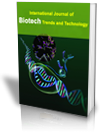Contactless Cardio Monitor: a Contactless Cardiovascular Monitoring Software
Citation
MLA Style:Lucas Macedo da Silva, Pedro Henrique de Brito Souza, Adson Ferreira da Rocha, Talles Marcelo G. de A. Barbosa "Contactless Cardio Monitor: a Contactless Cardiovascular Monitoring Software" International Journal of Biotech Trends and Technology 10.4 (2020): 30-37.
APA Style:Lucas Macedo da Silva, Pedro Henrique de Brito Souza, Adson Ferreira da Rocha, Talles Marcelo G. de A. Barbosa (2020). Contactless Cardio Monitor: a Contactless Cardiovascular Monitoring Software. International Journal of Biotech Trends and Technology, 10(4), 30-37.
Abstract
Cardiovascular diseases lead the world ranking of causes of death. The ubiquitous health monitoring is essential because it allows for an early diagnosis and prevents fatalities. Physiological variables that provide information about the cardiovascular system can be estimated by the photoplethysmographic signal (PPG), which can be recovered without contact with the camera. This work presents software capable of estimating physiological variables from the PPG signal obtained by a camera. They are also features implemented to improve the usability of the software.
References
[1] Share of deaths by cause. (n.d.). Our World in Data. Retrieved December 1, 2020, from https://ourworldindata.org/grapher/share-of-deaths-by-cause
[2] Araujo, L. C. de, & Romero, B. (2015). Pain: evaluation of the fifth vital sign. A theoretical reflection. Revista Dor, 16(4). https://doi.org/10.5935/1806-0013.20150060
[3] Deng, L., Zhang, Y., & Mo, H. (2018). Evaluation of TT-Based Local PWV Estimation for Different Propagation Velocities. Proceedings of the 2018 5th International Conference on Biomedical and Bioinformatics Engineering - ICBBE ’18. https://doi.org/10.1145/3301879.3301894
[4] Mukkamala, R., & Hahn, J.-O. Toward Ubiquitous Blood Pressure Monitoring via Pulse Transit Time: Predictions on Maximum Calibration Period and Acceptable Error Limits. IEEE Transactions on Biomedical Engineering, 65(6), (2018) 1410–1420. https://doi.org/10.1109/tbme.2017.2756018
[5] Pereira, T., Correia, C., & Cardoso, J. Novel Methods for Pulse Wave Velocity Measurement. Journal of Medical and Biological Engineering, 35(5), (2015) 555–565. https://doi.org/10.1007/s40846-015-0086-8
[6] Nabeel, P. M., Jayaraj, J., & Mohanasankar, S. Single-source PPG-based local pulse wave velocity measurement: a potential cuffless blood pressure estimation technique. Physiological Measurement, 38(12), (2017) 2122–2140. https://doi.org/10.1088/1361-6579/aa9550
[7] Kiran V., R., P.M., N., Joseph, J., Shah, M. I., & Sivaprakasam, M. Evaluation of Local Pulse Wave Velocity using an Image Free Ultrasound Technique. 2018 IEEE International Symposium on Medical Measurements and Applications (MeMeA). https://doi.org/10.1109/memea.2018.8438649
[8] P M, N., Karthik, S., Joseph, J., & Sivaprakasam, M. Arterial Blood Pressure Estimation From Local Pulse Wave Velocity Using Dual-Element Photoplethysmograph Probe. IEEE Transactions on Instrumentation and Measurement, 67(6), (2018) 1399–1408. https://doi.org/10.1109/tim.2018.2800539
[9] Myint, C., Lim, K. H., Wong, K. I., Gopalai, A. A., & Oo, M. Z. (2014). Blood Pressure measurement from Photo-Plethysmography to Pulse Transit Time. 2014 IEEE Conference on Biomedical Engineering and Sciences (IECBES). https://doi.org/10.1109/iecbes.2014.7047550
[10] Khong, W. L., Rao, N. S. V. K., & Mariappan, M. (2017). Blood pressure measurements using non-contact video imaging techniques. 2017 IEEE 2nd International Conference on Automatic Control and Intelligent Systems (I2CACIS). https://doi.org/10.1109/i2cacis.2017.8239029
[11] Sugita, N., Obara, K., Yoshizawa, M., Abe, M., Tanaka, A., & Homma, N. (2015). Techniques for estimating blood pressure variation using video images. 2015 37th Annual International Conference of the IEEE Engineering in Medicine and Biology Society (EMBC). https://doi.org/10.1109/embc.2015.7319325
[12] Guazzi, A. R., Villarroel, M., Jorge, J., Daly, J., Frise, M. C., Robbins, P. A., & Tarassenko, L. (2015). Non-contact measurement of oxygen saturation with an RGB camera. Biomedical Optics Express, 6(9), 3320. https://doi.org/10.1364/boe.6.003320
[13] Shao, D., Liu, C., Tsow, F., Yang, Y., Du, Z., Iriya, R., Yu, H., & Tao, N. (2016). Noncontact Monitoring of Blood Oxygen Saturation Using Camera and Dual-Wavelength Imaging System. IEEE Transactions on Biomedical Engineering, 63(6), 1091–1098. https://doi.org/10.1109/TBME.2015.2481896
[14] P., M., W., A., H., P., & M., T. (2020). A Photoplethysmographic Monitor for Local Pulse Wave Velocity Measurement. International Journal of Computer Applications, 177(31), 62–67. https://doi.org/10.5120/ijca2020919811
[15] McDuff, D., Gontarek, S., & Picard, R. W. Remote Detection of Photoplethysmographic Systolic and Diastolic Peaks Using a Digital Camera. IEEE Transactions on Biomedical Engineering, 61(12), (2014) 2948–2954. https://doi.org/10.1109/tbme.2014.2340991
[16] Kong, L., Zhao, Y., Dong, L., Jian, Y., Jin, X., Li, B., Feng, Y., Liu, M., Liu, X., & Wu, H.. Non-contact detection of oxygen saturation based on visible light imaging device using ambient light. Optics Express, 21(15), (2013) 17464. https://doi.org/10.1364/oe.21.017464
[17] SOUZA, P. H. B. (2019). Método para estimação da frequência cardíaca e variabilidade cardíaca com base em fotopletismografia por vídeo. Dissertação de Mestrado em Engenharia Biomédica, Publicação 109A/2019, Programa de Pós-Graduação em Engenharia Biomédica, Faculdade Gama, Universidade de Brasília, Brasília, DF, 154p.
[18] MARTINS, P. C. M. L. Validação do software HRVCam para avaliação da frequência cardíaca e da variabilidade da frequência cardíaca. 2019. Dissertação de Mestrado (Mestrado em Atenção à Saúde), Pontifícia Universidade Católica de Goiás, Goiânia.
[19] Tarvainen, M. P., Ranta-aho, P. O., & Karjalainen, P. A. An advanced detrending method with application to HRV analysis. IEEE Transactions on Biomedical Engineering, 49(2), (2002) 172–175. https://doi.org/10.1109/10.979357
[20] SOUZA, Pedro H. B., SOUZA, Israel. M. B., ALCALÁ, Symone G. S., VITORINO, Priscila V. de O., BARBOSA, Talles M. G. de A., ROCHA, Adson F. da. (2020). Video-based Photoplethysmography and Machine Learning Algorithms to Achieve Pulse Wave Velocity [Unpublished manuscript]. School of Exact and Computer Sciences, Pontifical Catholic University of Goiás.
[21] Naeini, E. K., Azimi, I., Rahmani, A. M., Liljeberg, P., & Dutt, N. A Real-time PPG Quality Assessment Approach for Healthcare Internet-of-Things. Procedia Computer Science, 151, (2019) 551–558. https://doi.org/10.1016/j.procs.2019.04.074
[22] Giavarina, D.. Understanding Bland Altman analysis. Biochemia Medica, 25(2), (2015) 141–151. https://doi.org/10.11613/bm.2015.015
[23] Fitzpatrick, T. B. The validity and practicality of sun-reactive skin types I through VI. Archives of Dermatology, 124(6), (1988) 869–871. https://doi.org/10.1001/archderm.124.6.869
[24] van Gastel, M., Stuijk, S., & de Haan, G. A new principle for measuring arterial blood oxygenation, enabling motion-robust remote monitoring. Scientific Reports, 6(1) (2016). https://doi.org/10.1038/srep38609
Keywords
Pulse Transit Time, Pulse Wave Speed, Oxygen Saturation, Blood Pressure, Camera, Non-Contact


